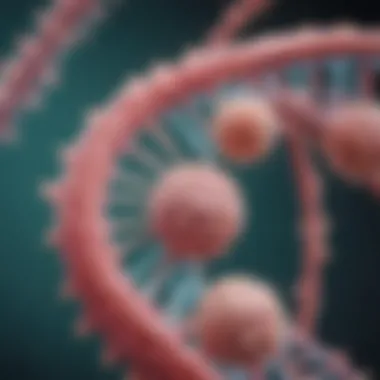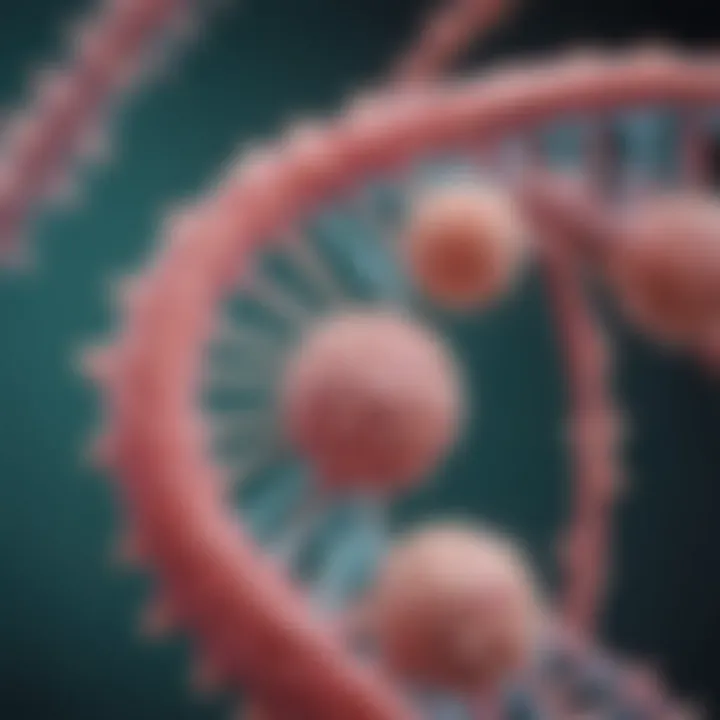Exploring the Link Between BRCA Mutations and Ovarian Cancer


Intro
Ovarian cancer, while often overshadowed by other types of cancer, holds a significant place in the discussion of women's health. At the center of ongoing research and clinical interest is the BRCA gene, specifically BRCA1 and BRCA2. These genes, when mutated, can drastically increase the risk of developing ovarian cancer among other malignancies. Understanding the intricacies of BRCA mutations offers insights not only into the genetic foundations of ovarian cancer but also the broader implications for prevention and treatment.
As we venture into this discussion, it's essential to grasp some key concepts surrounding both the BRCA genes and ovarian cancer. The relationship between these elements is multifaceted, comprising genetic, clinical, and psychological aspects that merit careful consideration.
Key Concepts
Definition of Primary Terms
- BRCA Genes: The BRCA1 and BRCA2 genes are crucial for the repair of DNA breaks. When they function properly, they help maintain the integrity of a cell's genetic information. However, mutations render them ineffective, leading to increased susceptibility to cancers, particularly breast and ovarian cancers.
- Ovarian Cancer: This refers to cancer that starts in the ovaries, the female reproductive organs that produce eggs. The symptoms can be vague, leading to late diagnoses. Risk factors include age, family history, and genetic predispositions, notably BRCA mutations.
Related Concepts and Theories
To appreciate the implications of BRCA mutations, a few related concepts come to light:
- Genetic Penetrance: This refers to the likelihood that a mutation will result in disease. Not all individuals with BRCA mutations will develop ovarian cancer, hinting at the role of other factors, including environment and lifestyle.
- Genetic Counseling: Families affected by mutations in BRCA may engage with genetic counselors to better understand their risks and consider genetic testing.
- Preventive Measures: Women with high genetic risk sometimes opt for proactive measures, such as prophylactic surgeries, which involve the removal of at-risk tissue to prevent cancer development.
"Knowledge is power as they say, and for women with a family history of ovarian cancer, understanding one’s genetics can be a game changer in making informed decisions."
Future Directions
Gaps Identified in Current Research
Despite accumulating knowledge, there remain significant holes in our research. For example:
- Lack of Diverse Population Studies: Much of the current data on BRCA mutations stems from specific population groups, mainly of European descent. This raises concerns about the generalizability of findings.
- Longitudinal Studies: There is a need for long-term studies that follow individuals over time to understand outcomes better and refine risk assessment.
Suggestions for Further Studies
Future studies could focus on various avenues:
- Exploring Gene Interactions: Understanding how BRCA interacts with other genes may illuminate pathways that contribute to cancer risk.
- Examining Environmental Factors: Research should delve into how lifestyle choices and exposures may influence outcomes for those with BRCA mutations.
- Innovative Treatments: The pathway from discovery to treatment can be lengthy. Research leading to breakthroughs in BRCA-targeted therapies could present new opportunities for managing ovarian cancer.
As we unravel these complexities, it becomes clearer that comprehending the relationship between BRCA mutations and ovarian cancer isn't merely an academic exercise. It holds real implications for prevention, treatment, and ultimately, survival.
Prolusion to BRCA and Ovarian Cancer
In the world of genetics and oncology, the names BRCA1 and BRCA2 resonate deeply, serving as crucial players in the landscape of hereditary cancer. Understanding the intersection of BRCA mutations and ovarian cancer not only sheds light on the mechanisms behind these diseases but also emphasizes the significance of timely interventions. This connection is paramount for women, especially those with a family history of ovarian or breast cancer, as it carries profound implications for screening, prevention, and treatment options.
As we navigate this topic, it becomes clear that increasing awareness about BRCA mutations plays a vital role in reshaping the conversation around genetic counseling and testing. Equipped with knowledge, individuals can make informed decisions about their health, ultimately altering their destinies.
Overview of BRCA Genes
BRCA genes, specifically BRCA1 and BRCA2, function as tumor suppressor genes. Essentially, they produce proteins that help repair damaged DNA, thereby ensuring cell stability and preventing unchecked cell growth. When there are mutations in these genes, the ability to fix DNA damage diminishes, leading to an increased risk of certain cancers. While these genes are commonly associated with breast cancer, it is critical to emphasize their substantial role in ovarian cancer as well.
Women who harbor mutations in these genes face a significantly heightened risk of developing ovarian cancer compared to those without such mutations. Research shows that women with BRCA1 mutations have up to a 44% chance of being diagnosed with ovarian cancer by age 70; BRCA2 mutations elevate this risk to roughly 17%. This underscores the need for understanding these genes not only from a genetic perspective but also from a public health standpoint.
Definition of Ovarian Cancer
Ovarian cancer arises when abnormal cells grow uncontrollably in the ovaries, which are the female reproductive glands responsible for producing eggs and hormones. There are different types of ovarian cancer, with epithelial tumors being the most prevalent, originating from the surface cells of the ovaries. Other types include germ cell tumors and stromal tumors, but they are less common.
The challenges presented by ovarian cancer are manifold. Symptoms can be vague and easily mistaken for other conditions, leading to delays in diagnosis. Often, women may not recognize the signs until the disease has progressed significantly. Understanding the nature of ovarian cancer, particularly its connection to genetic factors like BRCA mutations, can empower women to seek timely medical advice, thereby improving outcomes.
"Awareness and education about genetic risks are crucial for early detection and preventive strategies."
By piecing together the strands of information regarding BRCA and ovarian cancer, we pave the way for a more profound comprehension that may lead to better preventive measures, innovations in treatment, and ultimately, hope for many affected by these conditions.
Genetic Foundations of BRCA


Understanding the genetic foundations of BRCA is pivotal in comprehending the broader implications of BRCA mutations in relation to ovarian cancer. The BRCA genes—BRCA1 and BRCA2—have significant roles not just as indicators of hereditary breast and ovarian cancer syndromes, but also in understanding the underlying mechanisms of DNA repair. The insights gained from exploring these genetic foundations highlight how mutations in these genes can drastically influence cancer predisposition, treatment responses, and preventive strategies.
Each BRCA gene provides instructions for protein production that are crucial for repairing damaged DNA. When these genes are mutated, their ability to fix DNA breaks is compromised, leading to increased risks of cancer. This direct link between genetic integrity and cancer risk underscores the importance of studying BRCA in the context of ovarian cancer.
Structure and Function of BRCA Genes
BRCA1 and BRCA2 reside on chromosomes 17 and 13, respectively. These genes encode proteins that are integral to the repair of DNA double-strand breaks through a process called homologous recombination.
When functioning properly, BRCA1 protein is involved in regulating cell division, while BRCA2 plays a role in stabilizing a key protein necessary for DNA repair. Mutations can be inherited or can occur sporadically, leading to a loss of function. The implications of such mutations are profound—as they can significantly elevate the lifetime risk of developing ovarian and breast cancers.
The significance of BRCA genes lies in their function as guardians of the genome; their alteration can enact a cascade that may ultimately lead to malignancy.
This disruption in DNA repair pathways not only heightens cancer risk but also impacts how effectively certain cancers can be treated. For example, tumors with BRCA mutations may respond better to specific therapies such as PARP inhibitors, which exploit the defective DNA repair mechanism.
Inheritance Patterns of BRCA Mutations
The inheritance patterns of BRCA mutations can follow an autosomal dominant pattern. This means that inheriting just one mutated copy of the gene from an affected parent significantly increases the chance of developing the associated cancers.
- Direct inheritance: If one parent carries a mutation, each child has a %50 chance of inheriting that mutation, regardless of sex.
- Family clustering: Families with BRCA mutations often exhibit multiple cases of breast and ovarian cancer across generations.
Not only does this pattern emphasize the need for genetic counseling, but it also suggests a communal approach to screening for at-risk individuals within families. By understanding these inheritance patterns, affected individuals can make informed decisions regarding genetic testing, monitoring, and potential preventive measures.
In sum, the genetic foundations of BRCA bring to light essential elements concerning cancer risk and family dynamics, featuring an intricate dance between genetics and oncology. This foundational knowledge is not just beneficial—it's crucial for advancing personalized medicine and improving patient outcomes.
For more information on genetic concepts, you can check out Wikipedia or Britannica.
BRCA Mutations and Cancer Risk
The topic of BRCA mutations and their connection to cancer risk is pivotal in the exploration of ovarian cancer. Understanding this relationship opens doors for better risk assessment, diagnosis, and treatment strategies. It isn't just a matter of genetics; the BRCA genes, chiefly BRCA1 and BRCA2, act as caretakers of our DNA. When these genes are mutated, they lose their ability to protect against cancer development, especially in the ovaries and breasts. Therefore, comprehending how these mutations influence cancer susceptibility forms a crucial part of this discussion.
Statistical Overview of Ovarian Cancer Risk
When embarking on a discussion of ovarian cancer risk, the statistics unveil a sobering picture. Approximately 1 in 78 women will develop ovarian cancer during their lifetime. However, these numbers drastically change when factoring in BRCA mutations. Women with a BRCA1 mutation have an estimated 39% to 46% lifetime chance of being diagnosed with ovarian cancer. For those with a BRCA2 mutation, this risk hovers around 10% to 27%.
Consider some impactful figures:
- The average risk of a woman developing ovarian cancer by age 70 is roughly 1.3%.
- For women carrying BRCA1 mutations, this risk escalates significantly.
- Black and non-Hispanic White women present higher rates of BRCA mutations, leading to a disproportionately higher risk in these populations.
Moreover, these statistics highlight the need for targeted awareness efforts.
Role of BRCA1 and BRCA2 in Ovarian Cancer
Diving deeper, the BRCA1 and BRCA2 genes serve crucial roles in repairing DNA. BRCA1, for instance, is primarily involved in maintaining genome stability. If a woman inherits a defective BRCA1 gene, the risk of not only ovarian cancer but breast cancer climbs significantly. On the other hand, BRCA2, while sharing some functional similarities, plays a different role in DNA repair, particularly in the context of homologue recombination. Different types of cancers are associated with these genes, including pancreatic cancer and male breast cancer in those with BRCA2 mutations.
Understanding the specific contributions of these mutations helps researchers develop tailored strategies and therapies. For instance, the increased risk, combined with the genetic profile, can guide medical professionals in recommending preventive surgeries or monitoring programs for at-risk individuals.
"Identifying BRCA mutations acts like a double-edged sword; while it brings to light the risks, it also offers pathways to manage those risks more effectively."
In sum, knowledge of BRCA mutations is not merely academic; it carries real-world implications that influence clinical practices and patient choices. As research progresses, the understanding of these mutations and their role in ovarian cancer will only deepen, leading to potential breakthroughs in prevention and treatment.
Diagnosis and Testing
When it comes to understanding BRCA mutations and their role in ovarian cancer, the sections on diagnosis and testing stand out as critical pillars. These components not only provide a pathway to identifying genetic predispositions but also serve as a springboard for preventive strategies and targeted treatments. The significance of this topic lies in the dual benefits it offers: empowering individuals to make informed choices about their health and allowing healthcare professionals to tailor management plans effectively.
Genetic Testing for BRCA Mutations
Genetic testing for BRCA mutations is a specialized process that examines DNA for alterations typically found in the BRCA1 and BRCA2 genes. These mutations are notorious for increasing the risk of ovarian and breast cancers. The testing is often recommended for individuals with a family history suggesting a hereditary cancer risk. The process can be both straightforward and intricate, typically involving a blood sample or saliva, which is then analyzed in a lab.
The results of this test can be transformative. For high-risk individuals, finding out their BRCA status can lead to early interventions, such as increased surveillance or preventive surgeries. It’s not just about the individual; testing can also impact family members who may share these risk factors. Here are some key elements regarding BRCA mutation testing:


- Types of Tests: There are different tests available, which may include single-site testing, panel testing, and whole genome sequencing.
- Eligibility: Criteria often include family history, personal health history, and sometimes ethnicity, as certain populations have higher mutation rates.
- Risks and Limitations: It’s important to acknowledge that not all mutations are equally harmful, and the interpretation of results can be complex.
By equipping patients and families with this information, testing opens doors to not just understanding risk, but also to preemptive actions. The idea is to turn knowledge into power over one’s health decisions.
Interpreting Genetic Test Results
Once the genetic testing for BRCA mutations yields results, understanding what these findings mean becomes equally vital. The interpretation of genetic test results is not always a clear-cut affair. Some individuals may test positive for a mutation that confers a significant risk, while others might carry variants of uncertain significance (VUS), leading to confusion and concern.
When interpreting these results, consider the following aspects:
- Positive Result: This indicates the presence of a harmful mutation. Following this discovery, discussions about surveillance strategies, preventive measures, and treatment options are crucial.
- Negative Result: A negative test does not always mean it's safe to breathe easy. Family history and other risk factors still play a vital role in cancer risk assessments.
- VUS: Variants that are not well understood pose a challenge. They can cause uncertainty about future cancer risks and cause psychological stress.
"Understanding the nuances in test results is crucial. It is not about simply checking a box; it’s about comprehensively evaluating personal and familial health journeys."
Moreover, comprehensive genetic counseling is recommended to help patients navigate these results and their implications. With guidance, patients can explore their options, establish preventive measures, and communicate effectively with family members about their risks.
Overall, the sections on diagnosis and testing illuminate the pathway toward personalized healthcare strategies in BRCA-related ovarian cancer management.
Clinical Implications of BRCA Testing
The clinical implications of BRCA testing cannot be overstated. With a pivotal role in guiding patient care, understanding the results from BRCA gene mutation tests influences a wide array of medical decisions. For individuals, particularly those with a family history of breast or ovarian cancer, knowing their BRCA status can be a game changer. This knowledge serves not just as a benchmark for personal risk assessment but also as a foundation for tailored medical interventions.
Impact on Preventive Measures
When individuals find out they have a BRCA mutation, it opens the door to proactive prevention strategies. The implications stretch from increased surveillance measures to possible surgical options.
- Enhanced screening: Women with BRCA mutations are typically recommended to start screening for breast and ovarian cancers at an earlier age, including mammograms and MRIs.
- Prophylactic surgeries: Some may opt for preventive surgeries, such as mastectomies or oophorectomies, significantly reducing their chances of developing cancer.
- Chemoprevention: In certain cases, medications may be prescribed to lower risk levels, particularly for breast cancer.
These strategies are not without their emotional and physical tolls, but they represent a significant advance toward personalized medicine. The decision-making process here requires careful consideration, balancing the potential benefits against the risks.
Guidelines for High-Risk Patients
For individuals identified as high-risk, especially due to BRCA mutations, specific guidelines can provide a roadmap for effective management. Various organizations set out comprehensive frameworks aimed at optimizing care and ensuring that at-risk individuals undergo appropriate interventions.
- Regular consultations with healthcare providers: High-risk patients should maintain an ongoing dialogue with oncologists and genetic counselors, ensuring adjustments based on new discoveries and personal circumstances.
- Family history evaluation: Continuing to assess family health history can shed light on additional risk factors, further refining preventive strategies.
- Clinical trials: Engaging in clinical trials offers a dual benefit of contributing to advanced research while potentially accessing cutting-edge therapies.
In summary, the journey through BRCA testing has distinct clinical implications, particularly for those at high risk of ovarian and related cancers. It lays down a pathway for tailored prevention and treatment strategies that could mean the difference between life and death for many.
Understanding one's BRCA status is more than a medical label—it offers insights into a future filled with informed choices and empowered decisions.
This approach to management represents not just a clinical necessity but also a shift toward shared patient autonomy in health care decisions.
Treatment Options for BRCA-Associated Ovarian Cancer
The treatment landscape for BRCA-associated ovarian cancer has evolved significantly, driven by advances in genetic understanding and medical innovation. This topic is vital not only for patients directly affected by this condition but also for clinicians and researchers working to improve outcomes. The emphasis on personalized treatment strategies sets the stage for a more tailored approach, enhancing the effectiveness of interventions and improving quality of life for patients.
Overview of Current Treatment Modalities
The spectrum of treatment options for ovarian cancer generally includes surgical intervention, chemotherapy, and targeted therapies. Each modality serves a unique role, depending on the stage of cancer and the specific characteristics of the tumor.
- Surgery: For many patients, the first line of action is surgical. This typically involves a procedure called debulking surgery, which aims to remove as much of the tumor mass as possible. In cases where the cancer has spread extensively, a total abdominal hysterectomy with bilateral salpingo-oophorectomy may be performed. The goal is to reduce tumor burden and improve prognosis.
- Chemotherapy: Following surgery, chemotherapy may be administered. This treatment involves potent drugs that eliminate rapidly dividing cancer cells. Regimens often consist of combinations such as carboplatin and paclitaxel, which have shown effectiveness against ovarian cancer. One key consideration is the timing of chemotherapy—starting it after surgery often yields better results than delaying it until later.
- Targeted Therapies: Here lies a crucial distinction for BRCA mutation carriers. Targeted therapies are designed to specifically tackle vulnerabilities in cancer cells. In this context, agents such as PARP inhibitors have gained traction. They exploit the defective DNA repair mechanisms caused by BRCA mutations, selectively affecting cancerous tissues while sparing healthy cells. This individualized treatment leads to a more efficient attack on malignant cells.
Role of PARP Inhibitors
PARP inhibitors are a groundbreaking development in the management of BRCA-associated ovarian cancer. These drugs, including Olaparib, Niraparib, and Rucaparib, work by disrupting the poly (ADP-ribose) polymerase, an enzyme involved in DNA damage repair. For patients with BRCA mutations, the cancer cells are already at a disadvantage—they struggle to repair their DNA correctly. Adding a PARP inhibitor to the mix further compounds their vulnerabilities, leading to increased cell death.
"The emergence of PARP inhibitors marks a profound shift in the treatment paradigm for patients with BRCA mutations, allowing for more precise targeting of cancer cells while minimizing collateral damage to healthy tissue."
These drugs can be used in various contexts, including as maintenance therapy following initial treatments or in recurrent cases when traditional chemotherapy fails. Additionally, understanding the patient's genetic makeup is paramount when considering these therapies. This is where thorough genetic testing gains importance, as it determines eligibility and optimizes treatment plans.
In summary, the treatment of BRCA-associated ovarian cancer embraces a multifaceted approach. From traditional surgical and chemotherapy avenues to cutting-edge targeted therapy with PARP inhibitors, the journey toward more effective management strategies offers hope. Tailoring treatment based on genetic background plays a pivotal role in not just addressing the cancer, but also in improving the overall well-being of affected individuals.
Psychosocial Aspects of BRCA Testing


BRCA testing holds the potential to alter not just the medical landscape of patients but also their psychological well-being and family dynamics. Understanding the psychosocial aspects associated with BRCA gene testing is crucial, as it delves into how genetic results can shape thoughts, feelings, and overall family interactions. This knowledge touches on various components—mensal health, family dynamics, social stigmas, and personal identity—making it a comprehensive issue that needs thorough exploration.
Emotional Impact of Genetic Knowledge
Discovering one's BRCA status can be akin to opening a Pandora's box. The knowledge gained may provide a sense of control over one’s health, yet it also carries emotional burdens. Individuals may feel an array of emotions ranging from relief to anxiety. Knowing whether one carries a mutation can lead to early preventive measures, but it also generates questions that weigh heavily on the mind:
- What does this mean for my future?
- Will I develop cancer, and if so, when?
- How will this affect my loved ones?
Moreover, the stress associated with uncertain outcomes can be significant. A person may experience feelings of guilt, especially if a mutation is passed down to children. This knowledge can impact relationships, with family members potentially viewing each other through the lens of genetic risk. As such, open conversations between family members are vital, yet they can be an uphill battle. The emotional landscape is complex, and navigating through it requires support and resources.
"Genetic knowledge is like a double-edged sword; it empowers but can also paralyze with fear."
Support Systems for Patients and Families
A strong support system is essential for individuals undergoing BRCA testing and their families. Social networks can provide comfort and understanding, which are pivotal during times of emotional distress. Support groups, both online and offline, serve as spaces where individuals can share experiences and coping mechanisms. Here are some key avenues of support:
- Counseling Services: Professional counseling can offer specialized guidance, helping individuals process their emotions constructively.
- Peer Support Groups: Meeting others who have navigated similar challenges can often help alleviate feelings of isolation.
- Educational Resources: Detailed information about BRCA mutations and ovarian cancer can mitigate fears stemming from the unknown. Websites like en.wikipedia.org and britannica.com offer a wealth of knowledge.
- Family Meetings: Communicating openly with family about test results can strengthen relationships and help ease mutual fears.
To sum up, the psychosocial ramifications of BRCA testing are layered and multifaceted. Understanding the emotional impact and the significance of adequate support ensures a more holistic approach to dealing with genetic knowledge. The discourse surrounding these themes prepares both patients and families for the journey ahead, fostering resilience in the face of uncertainty.
Emerging Research in BRCA and Ovarian Cancer
As the landscape of oncology continuously evolves, the association between BRCA mutations and ovarian cancer is a dynamic area warranting attention. This emergence of research not only enhances our understanding, it is pivotal in adapting clinical practices to the ever-changing genetic and therapeutic landscape. The intersection of genetics and treatment for ovarian cancer remains a critical topic since it holds the promise of shifting paradigms in prevention, detection, and intervention strategies.
Innovations in Genetic Research
New frontiers in genetic research contribute significantly to our grasp of BRCA-related mechanisms. Scientists are deeply diving into understanding other genes that could either modulate or interact with BRCA genes. For instance, recent studies have hinted at the potential role of the PALB2 gene. It works together with BRCA2 in DNA repair, and mutations here may also elevate the risk for ovarian cancer.
Additionally, advanced genetic sequencing technologies are fostering insights into the complexities of cancer mutations. Polygenic risk scores, which aggregate the small effects of many genetic variants, highlight how an individual’s overall risk profile extends beyond just the BRCA mutations. This nuanced view not only informs on risk assessment but might lead to personalized strategies tailored for patients based on their entire genetic landscape.
These advances awaken possibilities for targeted interventions and more robust screening processes.
Future Directions in Treatment Strategies
As research goes deeper than the surface, treatment strategies are evolving, and the focus is shifting toward personalized medicine. The introduction of precision oncology—a method of treating patients based on their unique genetic make-up—is gaining traction. For BRCA mutation carriers, the application of PARP inhibitors has revolutionized treatment protocols. These inhibitors, such as Olaparib, target cancer cells with defective DNA repair capabilities, substantially improving patient outcomes.
Moreover, the pipeline of promising new therapies based on genetic insights continually expands. Clinical trials are underway to assess possible combinations of immune-oncology drugs with existing treatments, aiming to leverage the body’s immune response against cancer cells.
Given the insights from genetic research, an anticipatory shift toward neo-adjuvant therapies—treatments given before the main treatment—could also enhance outcomes for high-risk patients. This paves the way for making personalized treatment plans more effective and potentially less invasive.
"The future of BRCA-related treatment lies not just in understanding these genes, but in their integration into every phase of patient care—from prevention to long-term management."
Culmination and Recommendations
The intricate relationship between BRCA mutations and ovarian cancer necessitates a thoughtful and nuanced understanding. As we’ve explored in this article, comprehending how these genetic variations influence both the risk and behavior of ovarian cancer is imperative for effective patient management.
Even though the genetic architecture is relatively complex, highlighting essential insights can lead to improved healthcare outcomes. One of the critical takeaways is that individuals with a family history of ovarian cancer should seek genetic counseling and, if necessary, undergo testing for BRCA mutations. By doing so, they can better assess their own risk, tailor preventive measures, and make informed decisions regarding their health.
Today, advancements in therapies, particularly with the introduction of PARP inhibitors, represent a beacon of hope for those affected by BRCA-associated ovarian cancer. Such targeted treatments offer a more personalized approach, signifying a shift in oncology from generalized treatments to more individualized regimens that align closely with the genetic landscape of a tumor.
Summarizing Key Insights
In retrospect, several critical points emerge:
- Prevalence of BRCA mutations: It’s evident that these mutations significantly raise the risk of developing ovarian cancer, especially in women with a strong family history of the disease.
- Importance of Testing: Genetic testing is vital in identifying at-risk individuals, enabling earlier interventions and preventive measures.
- Innovative Treatments: There is promising development in treatments tailored for those with BRCA mutations, offering hope for better survival rates.
- Psychosocial Impact: The knowledge of being a BRCA mutation carrier brings with it emotional and psychological challenges, necessitating supportive networks.
These insights create a comprehensive framework for understanding how BRCA mutations affect ovarian cancer risk and management.
Call to Action for Researchers and Clinicians
The findings outlined in this article should serve as a call to action for both researchers and clinicians working in oncology.
- Further Research: More extensive studies examining the relationship between BRCA gene mutations and other forms of cancer are needed. Understanding the underlying genetic mechanisms can drive novel therapeutic advancements.
- Clinical Guidelines: There is an urgent need to integrate genetic testing into standard gynecological assessments, ensuring that high-risk patients receive necessary evaluations. Clinicians must be proactive in recommending genetic counseling as a part of routine care for patients with family histories suggestive of BRCA mutations.
- Educational Initiatives: Patients need to be informed about their options. Educational programs focusing on BRCA-related risks and treatment options should be developed and disseminated to empower patients in their health decisions.
As we look ahead, a collaborative effort among researchers, clinicians, and patients alike is essential to navigate the complexities of BRCA mutations and their associated cancer risks effectively. The continued evolution of this field offers a promising pathway forward, marked by enhanced patient care and improved outcomes.



